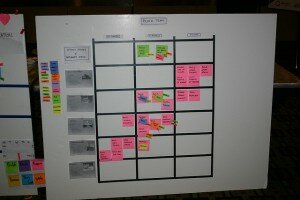Steve Bell at a glance—
- Author of Run Grow Transform and Lean Enterprise Systems (the first publication to use the term “Lean IT”)
- Co-author of Lean IT, which earned the 2011 Shingo Prize for Operational Excellence research award
- Serves on the faculty of the Lean Enterprise Institute and is a Lean Systems Society Fellow
- He travels worldwide, coaching, speaking, leading workshops and gemba walks, and advising clients on Lean IT strategy
- Steve is also the founder of Lean4NGO
For over thirty years, I have endeavoured to improve organisational performance with careful adoption of information systems. During this time, I’ve also helped to pioneer the emerging discipline of lean IT, striving to bring information systems and the lean enterprise into a harmonious balance clearly focused on value for the customer. Many would presume that my bias is towards the application of information technology – but that is not the case. Everything I have experienced and learned during these years of practice has reinforced my belief that we must emphasise people, process, and technology – in that order.
Information technology offers many valuable capabilities to the lean enterprise. It can automate repetitive activities, enable higher degrees of precision, eliminate wasteful redundancy and eliminate errors. It can provide information and analysis to promote informed decision making. It can help to capture and share vital knowledge, promoting communication and collaboration. Enabled by the internet, it can empower customers with information, making it easier for them to learn about products and services, and to transact and engage with us at high speed and low cost. And with the emerging fields of big data analysis and social media, information technology offers us the ability to listen to and engage with the virtual voice of the customer, identifying patterns and trends, and discovering potential customer preferences that otherwise would have gone unnoticed, helping to drive innovation forward.
As with any tool, information technology isn’t inherently good or bad. The value depends on how it is thoughtfully applied to a particular situation. When information technology is perceived as enabling the business to add value through process excellence, problem solving, enhanced product capability, and innovation, then it can be very useful. But information technology is often applied in an undisciplined silver bullet fashion, avoiding rigorous understanding of the underlying issues. Whenever this happens, the result can be costly.
In my experience, a significant portion of the IT project portfolio often consists of such ill-conceived, wasteful work, which consumes capacity without creating value. I have concluded that in many cases, the IT organisation doesn’t suffer from a capacity problem, but a quality problem. This impacts not only the effectiveness of the IT organisation, but the relationship and trust of its internal customers, the business process owners.
So the question you may be asking is, “how can I improve my organisation’s technology investments to improve the value we offer to our external customers?” Let’s begin by identifying some of the key problems, then explore possible countermeasures.
Common technology problems: There are many patterns that I’ve seen, that lead to such a quality problem. In this paper, we’ll focus on just a few of the more common, high-impact technology pitfalls that can impede the lean transformation.
Over-automation
There is a common temptation to strive for a 100% solution when implementing an information system. This can lead to unnecessary complexity and high cost of ownership and operation. The fact is that most business processes contain a degree of variation; some are natural and valuable, but some are wasteful. To automate non-value-adding variation only reinforces it, making it more difficult to eliminate later.
Improper problem analysis
Teams are often under great time pressure and other stresses to solve problems quickly and move on to the next crisis. This is a common malady in any enterprise and often leads to expedient technology fixes which address symptoms and not the underlying problems and their root causes. The result is new, non-value-adding technology components added to the complexity of the existing portfolio (more waste!), and the original problem has still not been eliminated.
Reinforcing silos
Many large-scale information systems (like ERP) are designed to automate transactions within a single, integrated system. They are intended to eliminate silos and facilitate the horizontal flow of, and access to, information. However, when not approached properly, they can unintentionally reinforce the siloed thinking and behaviour they hope to eliminate. Quite often when an integrated system is implemented, the project is chartered and budgeted, and the teams are structured to optimise vertical organisational functions, rather than the horizontal flow of value streams and supporting processes. This vertical optimisation is, in fact, sub-optimisation, with fragmentation and waste as the natural result.
Failure to consider total cost of ownership in IT investment decisions
Expedient technology investment decisions often do not consider all of the hard and soft costs of putting a system in place properly, maintaining it, and most significant in a lean enterprise, adapting it to changing conditions. Often the business stakeholders fail to anticipate their role, and do not budget (or mentally prepare themselves) for the time and energy required to design, test, deploy, maintain and change the system over the long term. Too often, they abdicate ownership of the system to IT, rationalising that because technology is involved, it is owned by IT, rather than recognising that the technology is a supporting element of the larger business process and value stream. As a result, once implemented, systems are often left to slowly decay, becoming dysfunctional and obsolete in a short period of time, and in the longer term, as we’ll discuss next, impede change.
Resistance to change
When any of these previously mentioned conditions exist, the result is a haphazard patchwork quilt of technology architecture, lacking a solid design and change management framework. With each new addition or change, the system becomes increasingly complex and fragile, and thus, resists change. Such systems can actually work as an anchor, impeding the ability of the enterprise to continuously improve its business processes and the systems that enable them. It’s no wonder why IT is often seen as an obstacle to the Lean Enterprise transformation.
Lean IT countermeasures
Lean thinkers like to speak in terms of countermeasures rather than solutions. Why? Because problems and circumstances change; what works now may lose effectiveness over time. Thinking in terms of countermeasures and PDCA (plan-do-check-act) experiments helps us to remember that continuous improvement is ongoing adaptation and learning. The implementation of an information system is the beginning, not the end of the investment and value creation process. So we need to change the traditional mindset associated with IT system implementations, application development, and system management, in order to support the overall lean enterprise. Here are a few ideas to consider.
Keep it simple
Whenever you’re considering a technology intervention, stop! First consider ways to simplify the process in a way that does not require automation: creativity before capital. Don’t seek to automate 100% of a process, rather rely on people to understand what variation is natural, and what is non-value-adding, and remove the latter. It’s also important to leave space in the process for human judgment and intervention, rather than try to automate all known variables and scenarios which may occur.
Grab an A3 and sort things out. Map your future state of the process. After several PDCA/kaizen cycles you may discover that your new current state is good enough without technology investment. You may even discover an opportunity to remove some old technology relics along the way.
After your initial efforts to simplify and improve the process, if a technology investment is still needed, the team should now have a clear understanding of the business case and requirements, and have a strong commitment to implement the change simply and quickly.
Make it visual
Electronic dashboards can be very attractive, and are useful in many situations. But they can be very passive for front-line workers and may actually reduce employee engagement, becoming tools for command and control by management. In a lean enterprise, each process owner and his/her team should first consider active visual management (pen and whiteboard, or other hands-on tools) to understand and continuously improve the flow of work and quickly spot problems. By active engagement of the senses, standing in front of the white board in real time to solve problems, the team develops an intuitive feeling for the process. And they can quickly and easily change the information gathered and displayed based on the changing needs of the process itself, without asking for technical assistance. While such manual displays may seem inefficient, they promote team ownership, learning and continuous improvement, which in the long run, are far more valuable.
Use rapid learning cycles
Once a technology project is underway, don’t eat the elephant in one bite. Lessons learned from lean product development (and its counterparts in the software development world, Agile and Scrum) show us that breaking a seemingly large project down into much smaller chunks (batch size and cycle time reduction) delivers more value, faster, with higher quality, far less risk, and more engaged stakeholders. Once the first small iteration of a project is deployed, your new understanding of the situation will most likely affect your plans for the next and subsequent iterations. And by treating each iteration as a PDCA cycle, measuring the outcome against your anticipated results, your ability to create a business case and estimate value with each new, small-batch-sized project improves. This not only improves the quality of each project, but also your ability to prioritise the project backlog to align with enterprise strategy (Hoshin Kanri).
Actively engage the users and stakeholders of the system
The customers and users of the system should be continuously engaged during design, development and testing of any new system, because the process involves emergent learning. No system is ever delivered that looks exactly like the original specifications. Thus, no longer should anyone be allowed to toss something over the wall to IT, asking only about when it will be delivered. This, of course, requires hard work and an investment in time by the business process owners, to ensure the system performs properly from the very start.
Strive for process and information excellence
According to Rother and Shook in their classic lean text, Learning to See (1999) “material and information flow are two sides of the same coin”. Thus business stakeholders need to own their processes and be responsible for making the right technology decisions to enable them. To do this they must engage the right expertise to make proper technical decisions, and enlist technologists’ support to sustain the resulting system. To flip the coin, technologists must gain an understanding of the larger view — the end customer need and the overall value stream — not just the technology in isolation. This becomes a true business and IT partnership – teamwork requiring trust and cooperation.
Summary
The fundamental premise of lean applies is creating value for customers, but the enterprise must first emphasise the development of its people. The capabilities that are developed include problem solving, teamwork across disciplines, visual management, leadership and strategic alignment. These capabilities are focused upon continuous improvement and innovation of business processes, in order to deliver the most value to its customers.




